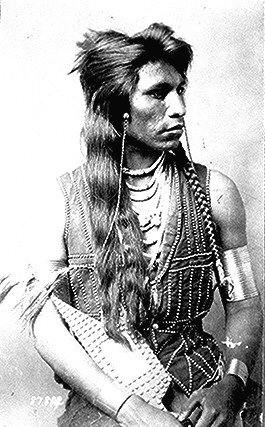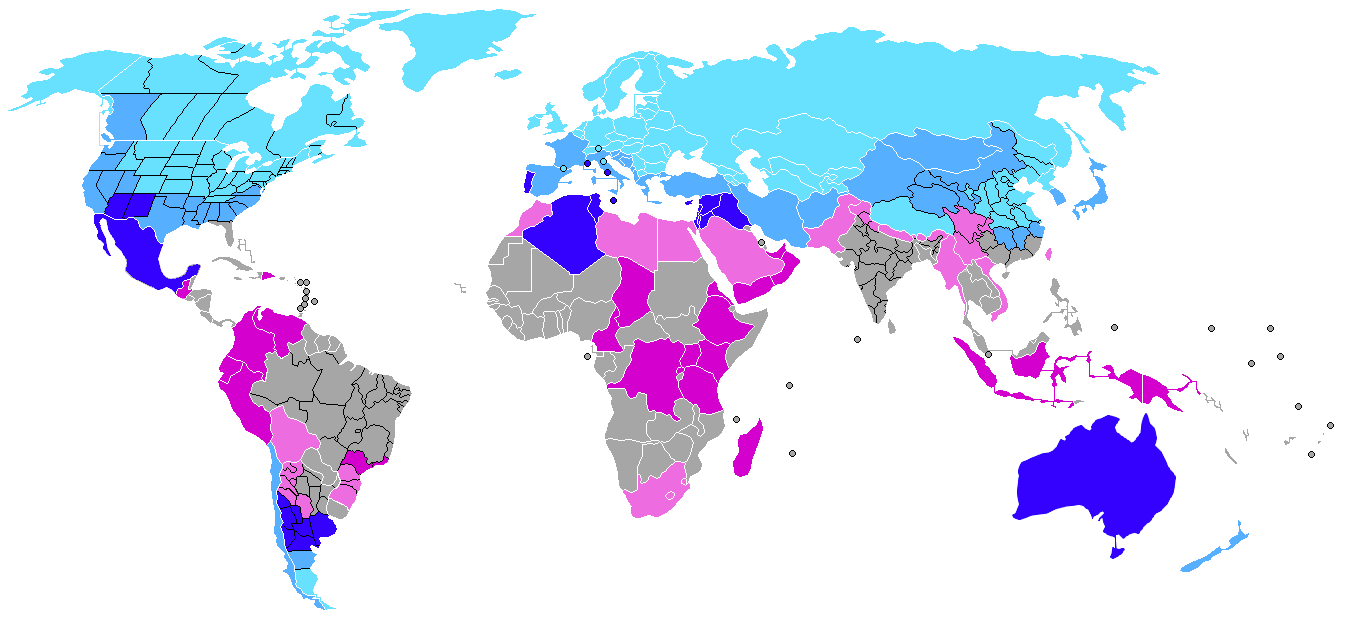|
Western Montana
Western Montana is the western region of the U.S. state of Montana. The most restrictive definition limits western Montana only to the parts of the state west of the Continental Divide. Other common definitions add in the mountainous areas east of the divide including Beaverhead, Gallatin, Jefferson, Lewis and Clark, Madison, and Park Counties. The region is sometimes considered to be part of the Inland Northwest. Geography, biomes and climate Western Montana is dominated by the Rocky Mountains. Most of Western Montana is covered in forest, prominent species being Ponderosa pine, aspen, and Rocky Mountain Douglas-fir. Common fauna include the black bear, moose, elk, and coyote. The grizzly bear lives in Glacier National Park, Yellowstone National Park, the Bob Marshall Wilderness and surrounding areas. Precipitation is lower in the valleys, which are mostly semiarid and receive 8 to 25 inches of precipitation, largely in snow, and higher in the mountains, s ... [...More Info...] [...Related Items...] OR: [Wikipedia] [Google] [Baidu] |
Montana Relief 1
Montana () is a state in the Mountain West division of the Western United States. It is bordered by Idaho to the west, North Dakota and South Dakota to the east, Wyoming to the south, and the Canadian provinces of Alberta, British Columbia, and Saskatchewan to the north. It is the fourth-largest state by area, the eighth-least populous state, and the third-least densely populated state. Its state capital is Helena. The western half of Montana contains numerous mountain ranges, while the eastern half is characterized by western prairie terrain and badlands, with smaller mountain ranges found throughout the state. Montana has no official nickname but several unofficial ones, most notably "Big Sky Country", "The Treasure State", "Land of the Shining Mountains", and " The Last Best Place". The economy is primarily based on agriculture, including ranching and cereal grain farming. Other significant economic resources include oil, gas, coal, mining, and lumber. The health c ... [...More Info...] [...Related Items...] OR: [Wikipedia] [Google] [Baidu] |
Coyote
The coyote (''Canis latrans'') is a species of canine native to North America. It is smaller than its close relative, the wolf, and slightly smaller than the closely related eastern wolf and red wolf. It fills much of the same ecological niche as the golden jackal does in Eurasia. The coyote is larger and more predatory and was once referred to as the American jackal by a behavioral ecologist. Other historical names for the species include the prairie wolf and the brush wolf. The coyote is listed as least concern by the International Union for Conservation of Nature, due to its wide distribution and abundance throughout North America. The species is versatile, able to adapt to and expand into environments modified by humans. It is enlarging its range by moving into urban areas in the eastern U.S. and Canada. The coyote was sighted in eastern Panama (across the Panama Canal from their home range) for the first time in 2013. The coyote has 19 recognized subspecies. The avera ... [...More Info...] [...Related Items...] OR: [Wikipedia] [Google] [Baidu] |
Pend D'Oreilles (tribe)
The Pend d'Oreille ( ), also known as the Kalispel (), are Indigenous peoples of the Northwest Plateau. Today many of them live in Montana and eastern Washington of the United States. The Kalispel peoples referred to their primary tribal range as ''Kaniksu''. Their traditional territory comprised the drainage systems of the Flathead River, Clark Fork, and Pend Oreille rivers. It extended from roughly present-day Plains, Montana, westward along the Clark Fork River, to Lake Pend Oreille and Priest Lake in Idaho, and the Pend Oreille River (''Ntxwe'', meaning "river") in eastern Washington and into British Columbia (Canada). They lived in many bands — originally, probably eleven — in their historic lands. They are generally divided geographically and culturally in two groupings: * the "upstream people" or Upper Kalispel (or "Upper Pend d’Oreille") are commonly referred to as the Pend d'Oreille. They were also known as ''Kullyspelm'' or ''Ql̓ispé'' ("Camas People"). They a ... [...More Info...] [...Related Items...] OR: [Wikipedia] [Google] [Baidu] |
Shoshone
The Shoshone or Shoshoni ( or ) are a Native American tribe with four large cultural/linguistic divisions: * Eastern Shoshone: Wyoming * Northern Shoshone: southern Idaho * Western Shoshone: Nevada, northern Utah * Goshute: western Utah, eastern Nevada They traditionally speak the Shoshoni language, part of the Numic languages branch of the large Uto-Aztecan language family. The Shoshone were sometimes called the Snake Indians by neighboring tribes and early American explorers. Their peoples have become members of federally recognized tribes throughout their traditional areas of settlement, often co-located with the Northern Paiute people of the Great Basin. Etymology The name "Shoshone" comes from ''Sosoni'', a Shoshone word for high-growing grasses. Some neighboring tribes call the Shoshone "Grass House People," based on their traditional homes made from ''sosoni''. Shoshones call themselves ''Newe'', meaning "People".Loether, Christopher"Shoshones."''Encyclopedi ... [...More Info...] [...Related Items...] OR: [Wikipedia] [Google] [Baidu] |
Kootenays
The Kootenays or Kootenay ( ) is a region of southeastern British Columbia. It takes its name from the Kootenay River, which in turn was named for the Kutenai First Nations people. Boundaries The Kootenays are more or less defined by the Kootenay Land District, though some variation exists in terms of what areas are or are not a part. The strictest definition of the region is the drainage basin of the lower Kootenay River from its re-entry into Canada near Creston, through to its confluence with the Columbia at Castlegar ''(illustrated by a, right)''. In most interpretations, however, the region also includes: * an area to the east which encompasses the upper drainage basin of the Kootenay River from its rise in the Rocky Mountains to its passage into the United States at Newgate. This adds a region spanning from the Purcell Mountains to the Alberta border, and includes Rocky Mountain Trench cities such as Cranbrook and Kimberley and the Elk Valley of the southern Cana ... [...More Info...] [...Related Items...] OR: [Wikipedia] [Google] [Baidu] |
Coast Salish Peoples
The Coast Salish is a group of ethnically and linguistically related Indigenous peoples of the Pacific Northwest Coast, living in the Canadian province of British Columbia and the U.S. states of Washington and Oregon. They speak one of the Coast Salish languages. The Nuxalk (Bella Coola) nation are usually included in the group, although their language is more closely related to Interior Salish languages. The Coast Salish are a large, loose grouping of many nations with numerous distinct cultures and languages. Territory claimed by Coast Salish peoples span from the northern limit of the Salish Sea on the inside of Vancouver Island and covers most of southern Vancouver Island, all of the Lower Mainland and most of Puget Sound and the Olympic Peninsula (except for territories of now-extinct Chemakum people). Their traditional territories coincide with modern major metropolitan areas, namely Victoria, Vancouver, and Seattle. The Tillamook or Nehalem around Tillamook, Oreg ... [...More Info...] [...Related Items...] OR: [Wikipedia] [Google] [Baidu] |
Libby, Montana
Libby is a city in northwestern Montana, United States and the county seat of Lincoln County. The population was 2,775 at the 2020 census. Libby suffered from the area's contamination from nearby vermiculite mines contaminated with particularly fragile asbestos, leading to the town's inclusion in the United States Environmental Protection Agency's National Priorities List status in 2002 and Public Health Emergency event in 2009. Most risk was reduced by 2015. Local natural features such as the Kootenai Falls have attracted tourism to the area and have been featured in movies such as '' The River Wild'' (1994) and '' The Revenant'' (2015). There is a public school district and a public library, and the town is in-district for Flathead Valley Community College, which operates the Lincoln County Campus there. History Continental and alpine glaciers shaped the area's valleys and lakes. The first indigenous peoples arrived at least 8,000 years ago and hunted and gathered for foo ... [...More Info...] [...Related Items...] OR: [Wikipedia] [Google] [Baidu] |
Temperate Rainforest
Temperate rainforests are coniferous or broadleaf forests that occur in the temperate zone and receive heavy rain. Temperate rain forests occur in oceanic moist regions around the world: the Pacific temperate rain forests of North American Pacific Northwest as well as the Appalachian temperate rainforest of the Eastern U.S. Sun Belt; the Valdivian temperate rain forests of southwestern South America; the rain forests of New Zealand and southeastern Australia; northwest Europe (small pockets in Great Britain and larger areas in Ireland, southern Norway and northern Iberia); southern Japan; the Black Sea–Caspian Sea region from the southeasternmost coastal zone of the Bulgarian coast, through Turkey, to Georgia, and northern Iran. The moist conditions of temperate rain forests generally support an understory of mosses, ferns and some shrubs and berries. Temperate rain forests can be temperate coniferous forests or temperate broadleaf and mixed forests. Definition Fo ... [...More Info...] [...Related Items...] OR: [Wikipedia] [Google] [Baidu] |
Snow
Snow comprises individual ice crystals that grow while suspended in the atmosphere An atmosphere () is a layer of gas or layers of gases that envelop a planet, and is held in place by the gravity of the planetary body. A planet retains an atmosphere when the gravity is great and the temperature of the atmosphere is low. ...—usually within clouds—and then fall, accumulating on the ground where they undergo further changes. It consists of frozen crystalline water throughout its life cycle, starting when, under suitable conditions, the ice crystals form in the atmosphere, increase to millimeter size, precipitate and accumulate on surfaces, then metamorphose in place, and ultimately melt, slide or Sublimation (phase transition), sublimate away. Snowstorms organize and develop by feeding on sources of atmospheric moisture and cold air. Snowflakes Nucleation, nucleate around particles in the atmosphere by attracting supercooling, supercooled water droplets, which ... [...More Info...] [...Related Items...] OR: [Wikipedia] [Google] [Baidu] |
Semiarid
A semi-arid climate, semi-desert climate, or steppe climate is a dry climate sub-type. It is located on regions that receive precipitation below potential evapotranspiration, but not as low as a desert climate. There are different kinds of semi-arid climates, depending on variables such as temperature, and they give rise to different biomes. Defining attributes of semi-arid climates A more precise definition is given by the Köppen climate classification, which treats steppe climates (''BSk'' and ''BSh'') as intermediates between desert climates (BW) and humid climates (A, C, D) in ecological characteristics and agricultural potential. Semi-arid climates tend to support short, thorny or scrubby vegetation and are usually dominated by either grasses or shrubs as it usually can't support forests. To determine if a location has a semi-arid climate, the precipitation threshold must first be determined. The method used to find the precipitation threshold (in millimeters): *multiply by ... [...More Info...] [...Related Items...] OR: [Wikipedia] [Google] [Baidu] |
Bob Marshall Wilderness
The Bob Marshall Wilderness Area is a congressionally-designated wilderness area located in Western Montana region of the United States. It is named after Bob Marshall (1901–1939), an early forester in the federal government, conservationist, and co-founder of The Wilderness Society. In the 1930s while working for the Forest Service, Marshall was largely responsible for designation of large areas to be preserved as roadless within lands administered by the Forest Service; he achieved this through promulgation of various regulations. Formally designated in 1964, the Bob Marshall Wilderness extends for 60 miles (95 km) along the Continental Divide and consists of 1,009,356 acres (4,085 km²). As directed by the Wilderness Act of 1964, "The Bob", as it is informally known, is to remain roadless. The only permanent structures here are some old ranger stations and horse bridges. "The Bob" is the fifth-largest wilderness in the lower 48 states (after the Death Valley Wild ... [...More Info...] [...Related Items...] OR: [Wikipedia] [Google] [Baidu] |








.jpg)